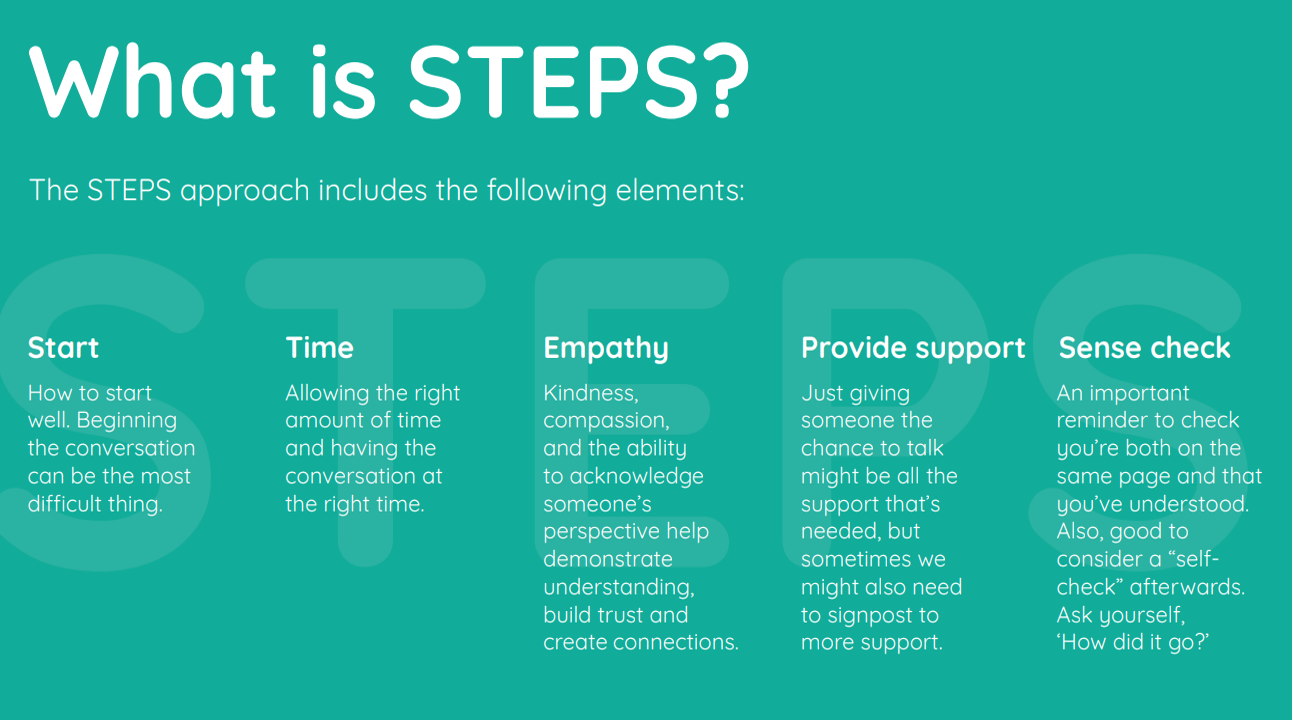STEPS: A framework for effective communication in healthcare
Effective communication is the lifeblood of healthcare. It’s the skill that underpins everything from delivering sensitive news to colleagues, supporting patients, resolving complaints, and building trust. However, many individuals struggle with initiating, sustaining, concluding, and following up on conversations. In the realm of healthcare education, simulation-based education (SBE) has emerged as a powerful tool to enhance communication skills. But to make the most of SBE, a structured communication skills framework is essential. While several such frameworks exist, we aimed to create a versatile, easily memorisable framework that could apply to a wide range of communication scenarios within SBE.

The building of STEPS: A framework for all conversations
Our journey began with a deep dive into existing communication skills frameworks, drawing insights from experts in communication skills, healthcare education, and SBE. SimComm wanted our framework to encompass the essential skills needed for every conversation, whether it’s between healthcare professionals and colleagues, patients, relatives, non-healthcare professionals, colleagues, or clients.
Through qualitative data analysis from sessions spanning five years, we identified key themes that formed the basis of our new framework:
- Why, When, Where, and How to Start a Conversation
- The Best Time for a Conversation
- Showing Empathy and Listening (Both Verbally and Nonverbally)
- Providing Support without Imposing Solutions
- Conducting a Sense Check After the Conversation
Two years ago, the STEPS framework was born. It has since been utilized by our facilitators in SBE to empower participants to confidently structure and engage in conversations.


Understanding the STEPS framework:
Start: Clarifying purpose and setting the stage
Before embarking on a conversation, it’s crucial to embark on the right foot. Start by defining the purpose and ultimate goal of the dialogue. What are you hoping to achieve? Understanding your objectives not only guides the conversation but also ensures that you stay on track and don’t veer off into unrelated territory.
Selecting the appropriate time and place is equally vital. Seek a setting that provides comfort, privacy, and minimizes distractions. This ensures that both you and the other person can focus on the conversation without external disturbances.
Consider the tone you want to set for the conversation. Approach it with an open mind and a non-confrontational demeanor. Using open-ended questions can be a powerful way to initiate dialogue. These questions encourage the other person to express themselves freely and provide more than just a yes or no answer. They invite discussion and create an atmosphere of collaboration and exploration.
Time to talk & listen: Patience as a virtue
In today’s fast-paced world, silence in a conversation can be uncomfortable. However, during discussions, especially those of a sensitive nature, embracing silence is crucial. Allow the other person time to process their thoughts and feelings. Resist the impulse to rush in with your own opinions, solutions, or judgments. Give them the space to articulate their emotions and perspectives at their own pace.
Active listening is essential to effective communication. It involves not just hearing the words spoken but truly comprehending their meaning. Maintain eye contact to demonstrate your engagement, nod to indicate understanding, and use verbal cues like “I see” or “Tell me more” to encourage the speaker. Active listening fosters trust and ensures that the other person feels heard and valued.
Empathy: The heart of connection
Empathy is the bridge that connects individuals on a deeper level. It involves being open and vulnerable to understanding the emotions and experiences of the other person. While empathy allows you to resonate with their feelings, it’s essential to keep the spotlight on them, not yourself.
To express empathy effectively, acknowledge their emotions without judgment. Phrases like “I can imagine how that must feel” or “That sounds really challenging” convey that you’re present and that their emotions are valid. Empathy is the cornerstone of building trust and strengthening interpersonal connections.
Provide support: Navigating complex solutions
Conversations often involve complex situations that don’t have straightforward solutions. In such cases, it’s essential to be transparent about the limitations of immediate solutions. While you may not have all the answers, indicating how and when you’ll follow up demonstrates commitment and care.
Discuss realistic action points that both parties can work on collaboratively. Avoid making empty promises or overcommitting. Clarity regarding the next steps and the available forms of support provides a roadmap for moving forward. It ensures that everyone is on the same page and understands their role in the process.
Sense check: Reflecting for growth
After concluding a conversation, take a moment for a sense check. Reflect on how the dialogue unfolded. Did it meet its intended goals? Was the other person’s perspective fully understood and respected? Seek feedback from the other person about how they felt the conversation went, ensuring their voice is heard.
Additionally, it’s crucial to conduct a personal check-in. Acknowledge any emotional toll that supporting others may have taken on you. Caring for your own emotional well-being is fundamental to your ability to support others effectively.
Incorporating these steps into your conversations can transform them into more meaningful and productive exchanges. Effective communication is not just about conveying information; it’s about building connections, fostering trust, and achieving positive outcomes for all parties involved.

Positive impact of STEPS:
Over 500 participants have embraced the STEPS framework, reporting its ease of remembrance and applicability in both professional and personal settings. Post-intervention surveys have shown a significant improvement in learners’ confidence and perceived competence in handling difficult conversations. Focus group discussions have highlighted how STEPS helps participants manage their emotions and foster open dialogues.
A framework for empowering conversations:
STEPS is more than just a communication skills framework; it’s a tool that empowers individuals to initiate, structure, and navigate conversations with kindness, leading to constructive outcomes. Its versatility allows it to be implemented in various settings by healthcare and non-healthcare professionals alike, making it an invaluable resource in enhancing person-centred communication. STEPS is the key to unlocking effective communication, creating a safer and more empathetic healthcare environment for all.
Join us in embracing STEPS and taking a leap towards improved communication and patient-centred care.
References
- Kurtz SM, Silverman JD. The Calgary-Cambridge Referenced Observation Guides: an Aid to Defining the Curriculum and Organizing the Teaching in Communication Training Programmes. Medical Education [Internet]. 1996 Mar;30(2):83–9. Available from: https://pubmed.ncbi.nlm.nih.gov/8736242/
- SAGE & THYME: Teaching everyone to listen – Welcome | SAGE & THYME [Internet]. www.sageandthymetraining.org.uk. Available from: https://www.sageandthymetraining.org.uk/
- Windover AK, Boissy A, Rice TW, Gilligan T, Velez VJ, Merlino J. The REDE Model of Healthcare Communication: Optimizing Relationship as a Therapeutic Agent. Journal of Patient Experience. 2014 May;1(1):8–13.
- Conigliaro R, Kuperstein J, Dupuis J, Welsh D, Taylor S, Weber D, et al. The PEEER Model: Effective Healthcare Team-Patient Communications. MedEdPORTAL Publications. 2013;





